VCS Workspace
A Scalr VCS workspace connects your infrastructure as code, managed by Terraform or OpenTofu, to a specific branch in a version control system repository. This integration automates the process of planning and applying infrastructure changes in response to code commits and pull requests.
Set Up
Connect a VCS repository if you haven't already. After selecting VCS as the source, set the following options:
Triggering Event
The triggering event determines what action will create a run when using VCS as the workspace source. There are two events to select from:
- Commit Pushed: Runs are triggered by commits and pull requests. Scalr triggers a run when a pull request is opened or a commit is created for the branch to which the workspace is linked.
- Tag Created: Runs are triggered when a git tag is published and matches the version constraint defined in the workspace settings. Only stable releases trigger runs; unstable releases can be added but do not trigger runs automatically. Automated dry runs are not currently available for tag-based workspaces, but they can be started through the UI, API, or CLI. Version constraint supports version ranges in the Terraform-like style, e.g.
~> 1.0.0,>= 1.0, <= 2.0, etc.
Settings
-
VCS Provider - Select the provider that contains the Terraform and OpenTofu repositories.
-
Repository - Select the repository where the code resides.
-
Terraform Working Directory - This is where Terraform commands are executed. This directory must be a subdirectory of the top level of the repository. This comes in handy in the case of a mono repo.
-
Trigger Strategy - The rules in which a run should be triggered based on files or folders being updated.
- Any Changes - Any change in the repository specified will trigger a run.
- Trigger Patterns - Use glob patterns to specify which files/directories should initiate a run. Patterns can be used in combination with a working directory, but not with trigger prefixes. For example, if the following patterns were set a run would execute if there were changes in
my/awesome/workdir/ormodules/core/iam/teams, but changes to any.mdfiles would be ignored.
my/awesome/workdir/ modules/core/iam/teams !*.md- Directories - Use a working directory as well as trigger prefixes to trigger a run based on any files being changed in any of the directory paths. Trigger prefixes cannot be used in combination with trigger patterns.
-
Trigger a plan-only run when a PR is opened/updated - This is a control mechanism to avoid unwanted dry runs on every commit. This is only available for the "Commit Pushed" triggering event.
-
Clone submodules - This allows you to specify whether git submodules should be fetched when cloning a VCS repository.
-
Select variable files - This specified which
tfvarsfiles should be pulled in from the repository. -
Skipping specific commits - If you would prefer that a run is not started based on a VCS commit or PR, add
[skip ci]in the first line of a head commit message. Users will still be able to queue runs manually if the configuration version is associated with a commit with the skip tag. Use[skip scalr ci]to avoid conflict with other CI tools that use the same message.
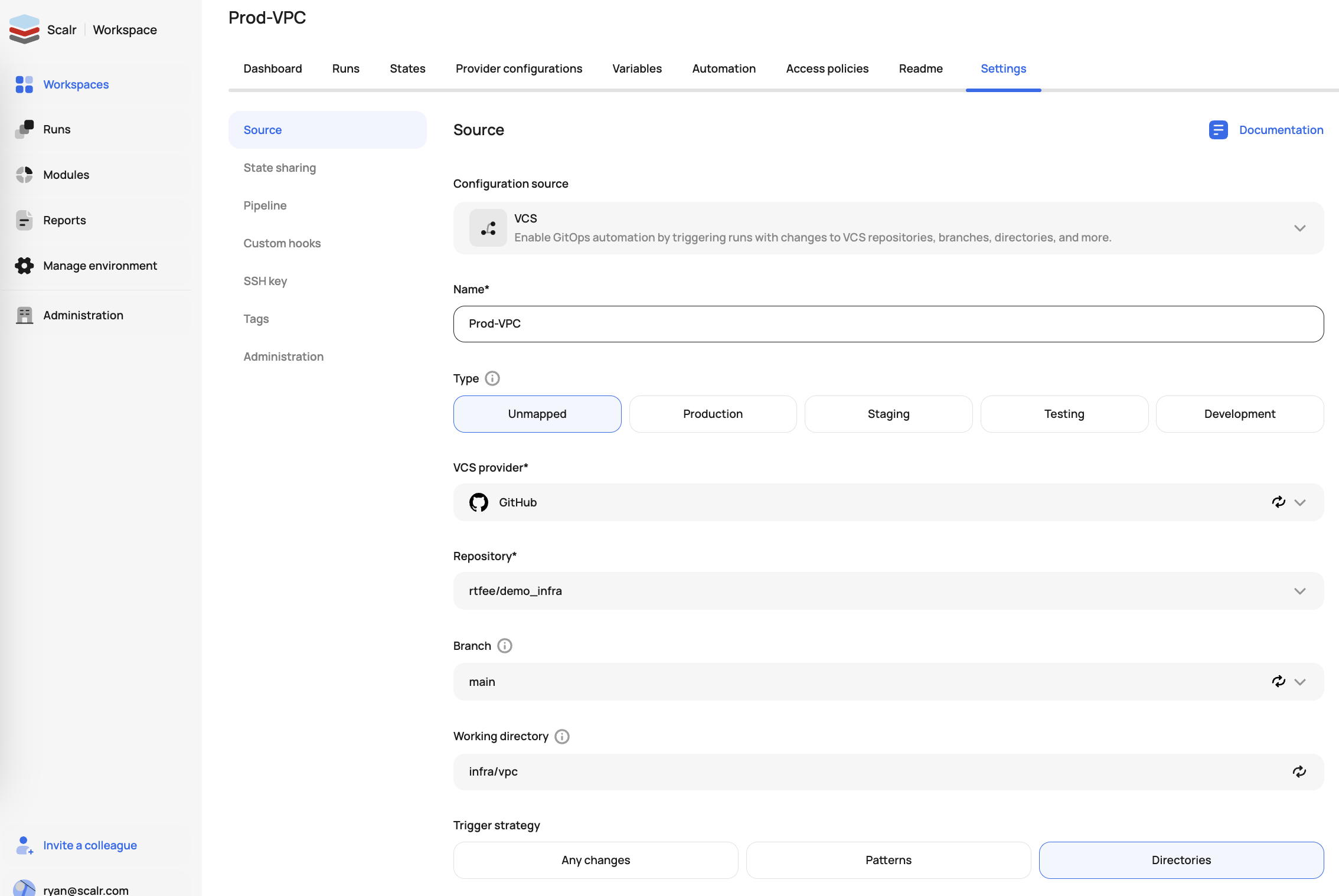
Pull Requests
For commit-based workspaces, Scalr will execute a dry run (plan-only) upon creating a pull request against the branch the workspace is linked to if the working directory or trigger pattern is affected. Subsequent commits to the pull request will also trigger a dry run regardless of the code changed in the new commit. Scalr evaluates all commits in the pull request on every new push, not just the latest commit.
If the "Send summary back to PR comments" is enabled in the VCS integration settings, Scalr will send plan summaries back to the PR comment:
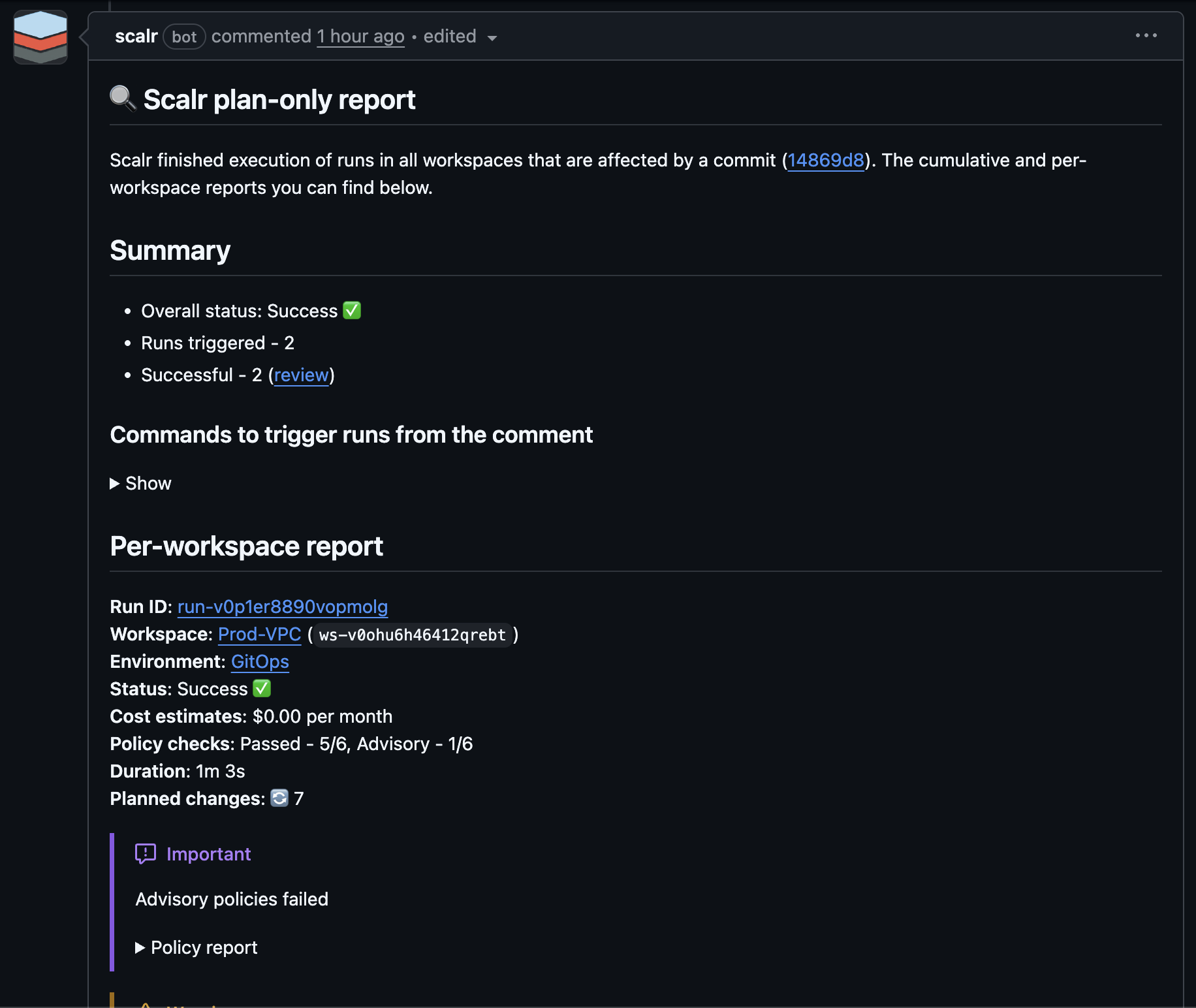
Alternatively, if "Send run results to pull request checks" is set (GitHub only) a pull request check will display the run results:
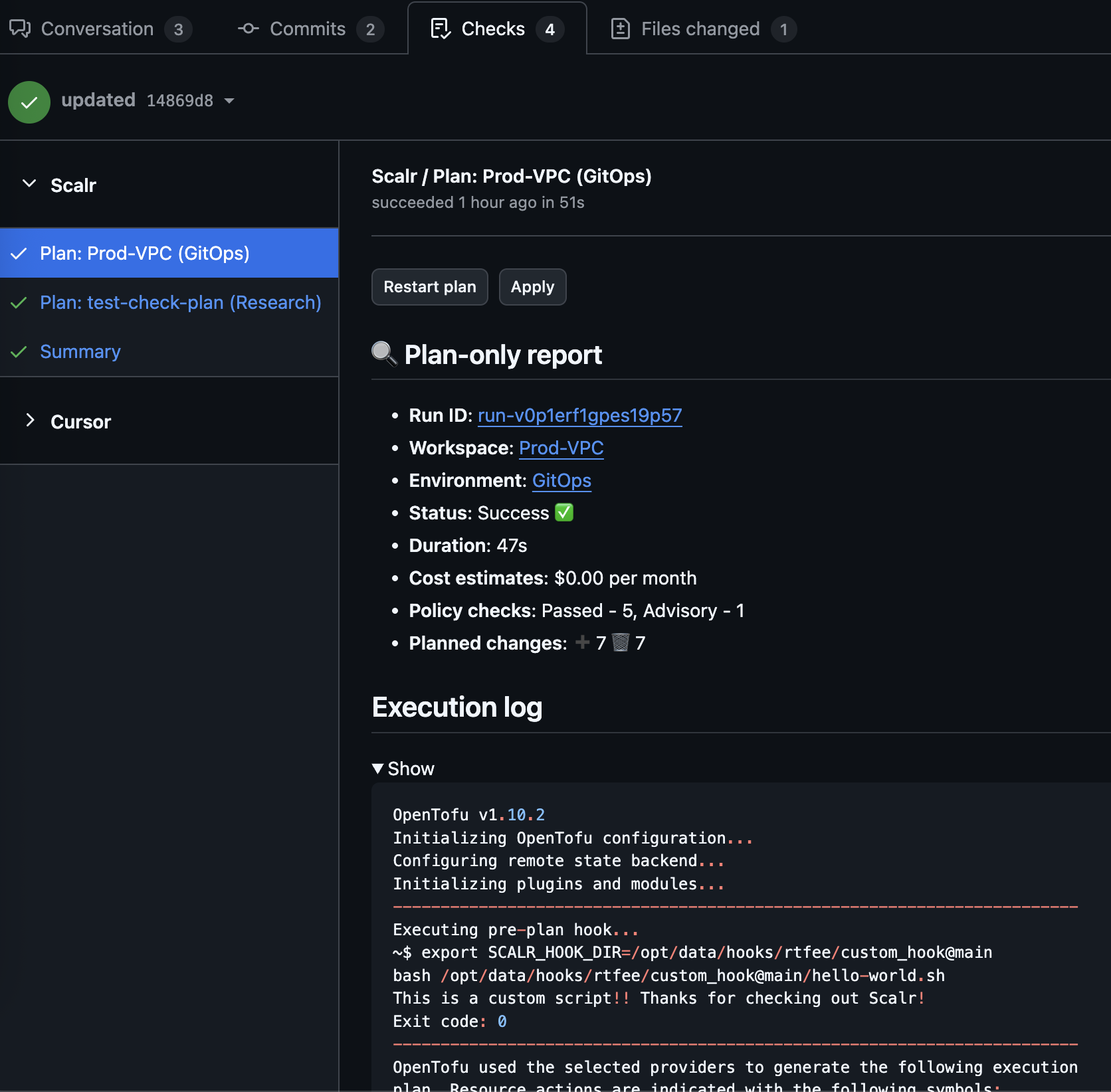
Select a Commit Strategy
While this is not a setting in the workspace itself, admins can choose between the following two commit strategies when add a VCS provider connection. All workspaces that use this VCS connection will inherit this setting:
Head Commit of the Base Branch: The default base commit strategy compares the latest head commit with the base branch commit
Previous Commit of the PR Branch: The commit compares the latest head commit with the previous head commit
The head commit strategy compares ALL commits in the PR every time a commit is pushed, while the previous commit strategy only compares the new commit to the previous commit that was made.
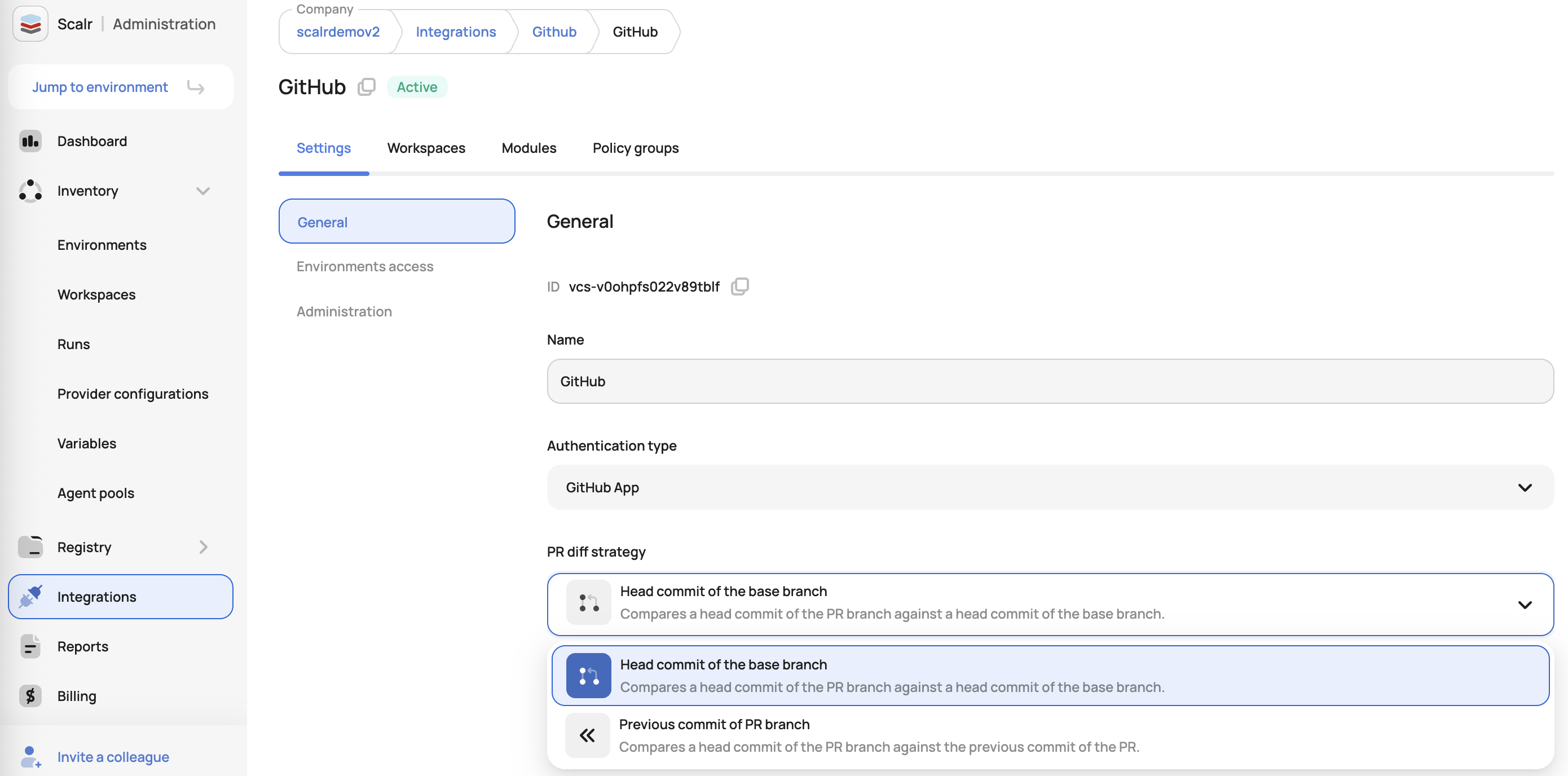
Pull Request Views
The pull request views in each workspace provide a real-time, centralized view of all PRs affecting that workspace. Users can view key details, including PR name, author, run status, and commit information. The list supports sorting, searching by PR ID or commit, and filtering by status. Requires the workspaces:read permission.
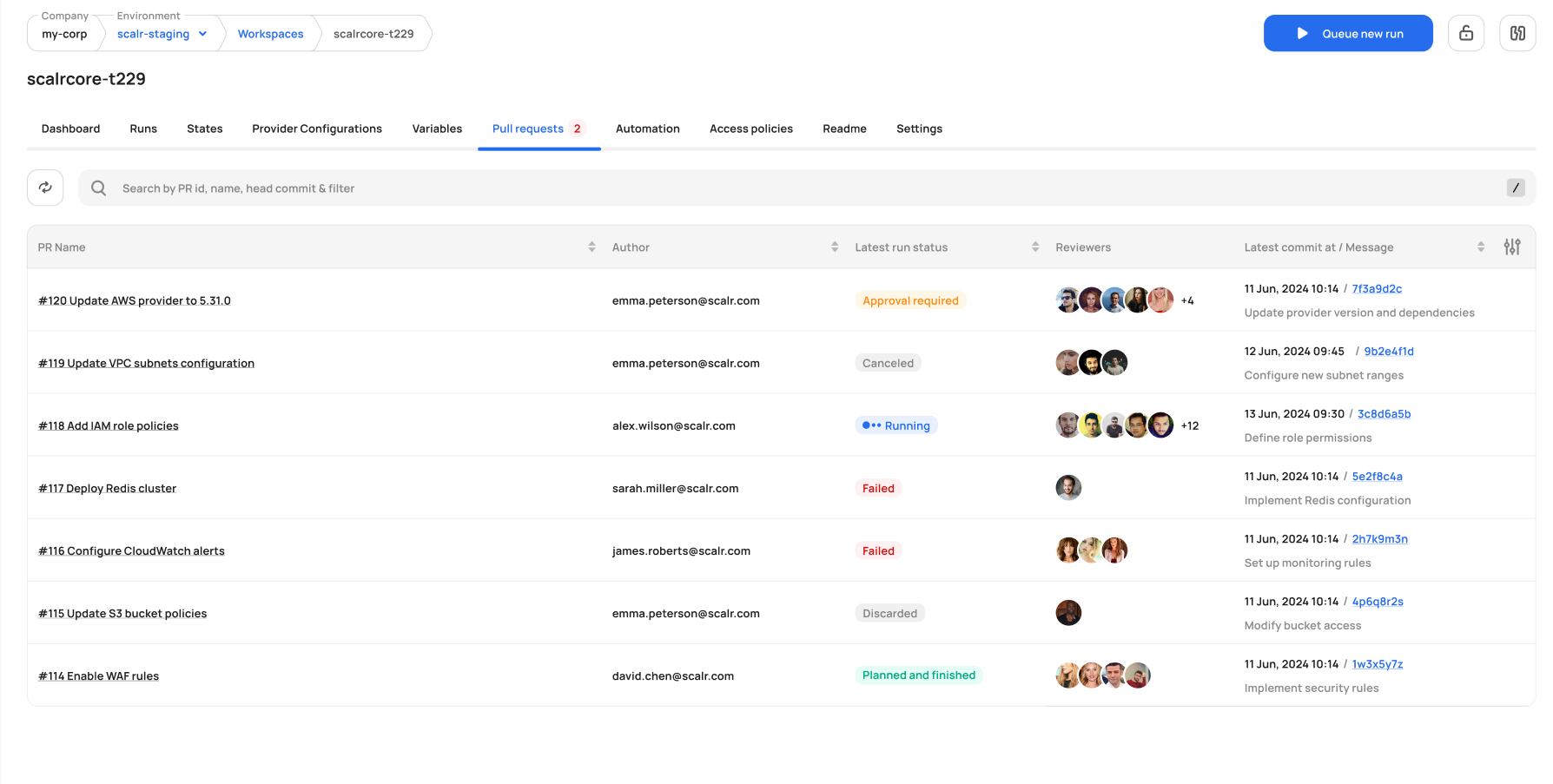
Execute a Run from a PR Comment or Check (Atlantis-Style)
From Comments
For VCS-based workspaces, a plan or apply run can be executed directly from a pull request comment. As of right now, GitHub, Gitlab, and Azure DevOps are supported. To execute a run from a comment, simply execute the following in a pull request comment:
/scalr planor
/scalr applyThe status of the run will be sent back to the VCS provider as a comment:
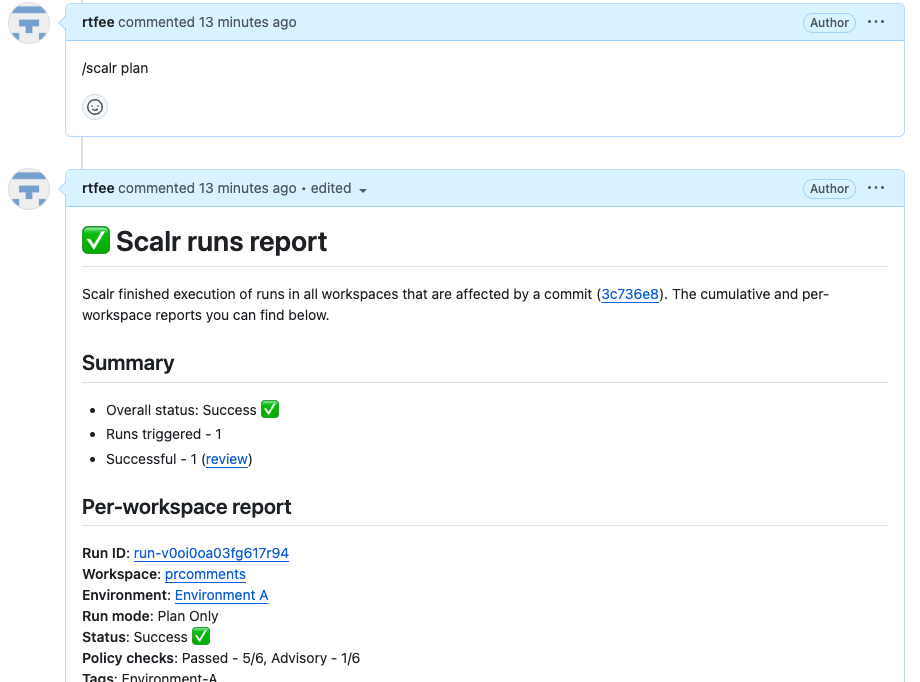
If the workspace setting "Enabled VCS-driven dry runs" is disabled, the /scalr plan command will not work, but apply will. To override this, use the -force flag to force a plan to execute: /scalr plan -force
Command List:
| Command | Description |
|---|---|
/scalr plan | Executes a dry run in Scalr and results are returned to the VCS provider. |
/scalr plan -force | Forces dry runs to execute even if the "Trigger a plan-only run when a PR is opened/updated" is disabled or the auto-queue runs is set to never in the workspace settings. |
/scalr apply | Executes an apply run in Scalr and results are returned to the VCS provider. |
/scalr apply -workspace-id=<workspace-id> | Executes a targeted apply on a specific workspace in Scalr. Useful when a repository is linked to many workspaces. |
/scalr apply -force | Forces apply runs to execute even if auto-queue runs is set to never. |
If the auto-queue run is set to never in the workspace settings, runs will not execute from pull request comments until it is changed to skip first or always. The default value is "Skip first".
Since the apply happens through a comment before the merge, users can avoid another apply executing when the pull request is merged by adding the following to the headcommit message of a pull request:
[skip scalr] or [skip ci]
The ability to execute runs from a comment is controlled through the VCS provider settings:
From Checks
Note: Checks are only available for GitHub
Alternatively, runs can be executed directly from a PR check if "Send run results to pull request checks" is enabled. At the top of each check, users can select between "Restart plan" and "Apply":
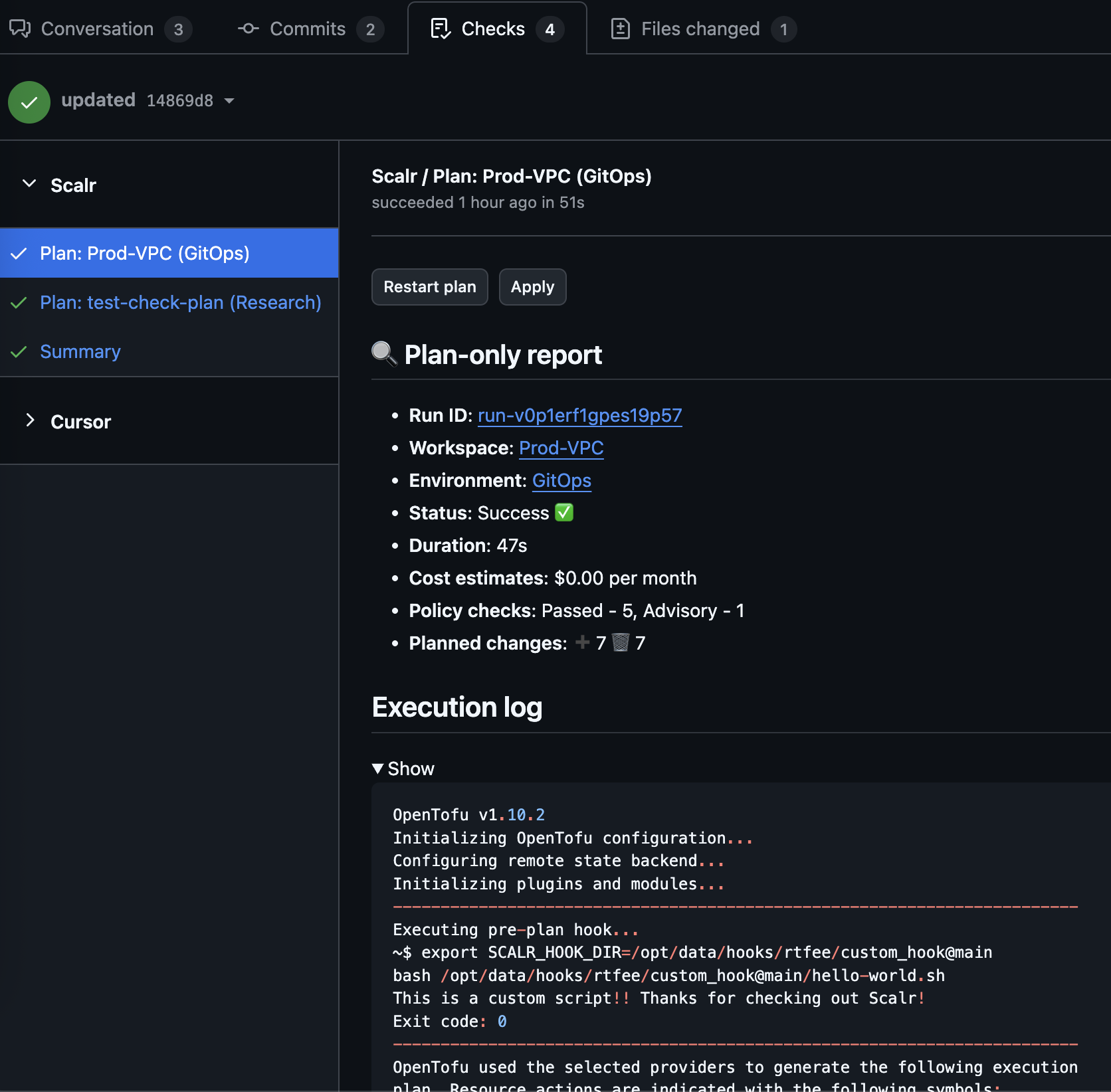
Avoid State Update by Unmerged PRs
Want to ensure that Terraform state modifications are only applied from the main workspace branch or a verified PR, preventing accidental overwrites or conflicts caused by unmerged changes?
Scalr safeguards your Terraform state from unintended modifications with branch awareness. Scalr displays warnings when changes are attempted from branches with unmerged pull requests, and automatically prevents auto-apply operations when the state-generating branch differs from your run's configuration branch. This ensures state modifications only occur from your main workspace branch or properly verified pull requests, preventing accidental overwrites and conflicts.

Prevent an Apply from a PR that Cannot be Merged
If you are using the apply before merge workflow, you want to make sure that the /scalr apply command can only be executed after a PR is approved and passes branch protection checks, so you can enforce compliance and prevent unauthorized Terraform changes. This can be done by checking the merge_error attribute in the run input. See more on this here.
Automatic Base Branch Merge Before Run Execution
VCS-driven workspaces can automatically merge the base branch into the head branch before triggering a run. This ensures that runs are always executed against the latest code in the base branch, providing more accurate and reliable results. This helps a common pain point where runs could be executed against outdated head branches, potentially leading to false-positive results or failed applies after merging.
To implement this feature, enable the auto-merge option when configuring the VCS provider:
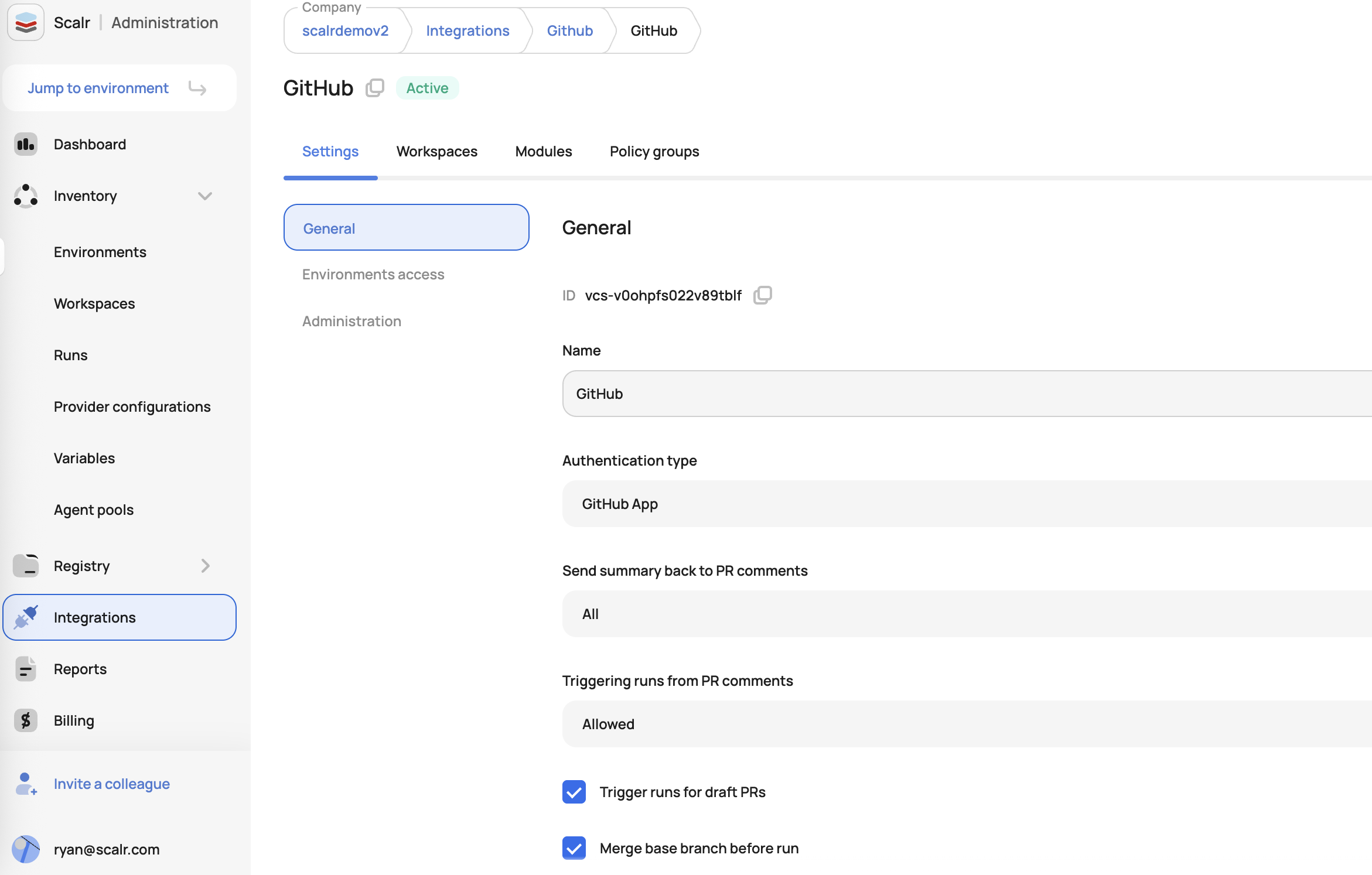
Approve a Run from a Pull Request
For VCS-based workspaces, an apply run can be approved or declined directly from a pull request comment. GitHub and Azure DevOps are currently supported; other VCS providers will be added soon. To approve or decline a run from a comment, simply execute the following commands in a pull request comment:
| Command | Description |
|---|---|
/scalr approve | Approves all runs in all workspaces related to the pull request. |
/scalr decline | Declines all runs in all workspaces related to the pull request. |
/scalr approve -workspace-id=ws-xxxxxxxxx | Approves a run in a specific workspace. |
/scalr decline -workspace-id=ws-xxxxxxxxx | Declines a run in a specific workspace. |
/scalr approve -workspace-id=ws-xxxxxxxxx,ws-yyyyyyyyy | Approves a run in a list of defined workspaces. |
/scalr decline -workspace-id=ws-xxxxxxxxx,ws-yyyyyyyyy | Declines a run in a list of defined workspaces. |
A reason can be added to all approvals with the -reason="Your reason here"argument:
/scalr approve -workspace-id=ws-xxxxxxxxx,ws-yyyyyyyyy -reason="Your reason here"A default Approved from VCS comment message will be added if no reason is given.
Permissions
For a user to be able to approve or decline a run, the following must apply:
- Users must have the same email address in both GitHub or Azure DevOps and Scalr.
- Users must have the
runs:applypermission otherwise, the approve or decline commands will not be permitted.
Provider Configurations
Before executing a run in a workspace, credentials must be added so that the code can authenticate to the Terraform provider during the run. This can be done through the Scalr provider configuration feature. Provider configurations give users a central place to manage their configurations and assign them for use within environments and workspaces.
Set Variables
Once the workspace is saved, variables might need to be added to the workspace if required. Find out more about setting shell and Terraform/Tofu variables here.
Execution
A run will execute upon the next commit, pull request, or manual execution of a run. Alternatively, you can set auto-queue run to always, which will automatically start a run upon the workspace being created. Auto queuing of runs is helpful when you automatically create workspaces through the Scalr provider as you can kick off a run in the workspace as soon as it is provisioned via Terraform without manual intervention.
Runs can also be triggered based on users adding a /scalr plan comment to the comments of a pull request.
Extra Settings
There are other optional settings that can be applied to all workspace types which can be found in workspace settings.
Updated 2 months ago
